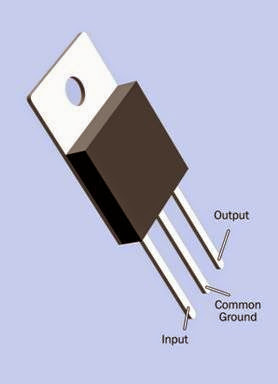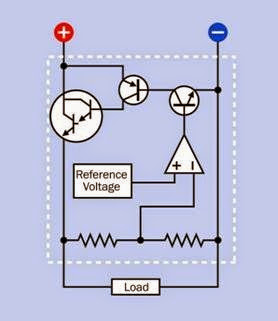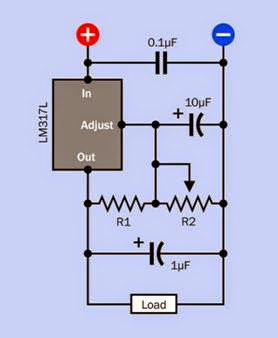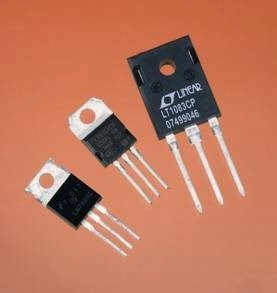Correctly known as a linear voltage regulator to distinguish it from a switching regulator or DC-DC converter. However, the full term is not generally used, and “voltage regulator” is normally understood to mean a linear voltage regulator.
A linear voltage regulator provides a tightly con trolled DC output, which it derives from an un regulated or poorly regulated DC input. The DC output remains constant regardless of the load on the regulator (within specified limits). It is a cheap, simple, and extremely robust component.
There is no single schematic symbol for a linear voltage regulator.
The general physical appearance of a commonly used type of regulator, rated for an output of around 1A DC, is shown at Figure 19-1. The LM7805, LM7806, LM7812, and similar regulators in the LM78xx series are encapsulated in this type of package, with pins that are spaced at 0.1” and have functions as shown. Other types of regulator may differ in appearance, or may look identical to this one but have different pin functions. Always check datasheets to be sure.
How It Works
and using the error value to control the base of a pass transistor that is placed between the input and the output of the regulator. Because the transistor operates below saturation level, its output current varies linearly with the current applied to its base, and this behavior gives the linear regulator is name. Figure 19-2 shows the relationship of these functions in simplified form; Figure 19-3 shows a little more detail, with a Dar ling ton pair being used as the pass transistor. The base of the pair is controlled by two other transistors and a comparator that delivers the error voltage. This version of a voltage regulator is known as the standard type.
The voltage difference required between the base and emitter of an NPN transistor is a mini mum of 0.6V. Because multiple transistors are used inside a standard-type voltage regulator, it requires a minimum total voltage difference, be tween its input and its output, of 2VDC. This volt age difference is known as the dropout voltage. If the voltage difference falls below this minimum, the regulator ceases to deliver a reliable output
voltage until the input voltage rises again. Low
All linear regulators function by taking some feedback from the output, deriving an error value by comparing the output with a reference voltage (most simply provided by a zener diode),
dropout regulators allow a lower voltage differ
ence, but are more expensive and less commonly used. They are described under the following Variants section.
Figure 19-1. The package design of a commonly used voltage regulator. Others may be significantly different, and the pin functions may vary. Check manufacturer da- tasheets for details.
Discrete components could in theory be used to build a voltage regulator, but this ceased to be cost-effective several decades ago. The term is now understood to mean one small integrated package containing the basic circuit augmented with additional, desirable features, such as automatic protection against overload and excessive heat. Instead of burning out if it is overloaded, the component simply shuts down. Most voltage regulators also tolerate accidentally reversed power connection (as when batteries are inserted the wrong way around) and accidentally re versed insertion of the regulator in a circuit board.
Other components can satisfy the requirement to deliver power at a reduced voltage. Most simply, if two resistors in series are placed across a
Figure 19-2. A linear voltage regulator basically consists of a transistor whose base is controlled by corrective feed- back derived from the output.
Figure 19-3. The fundamental internal features of a standard-type voltage regulator, including a Darlington pair, two transistors, a voltage divider, comparator, and reference voltage source, shown inside the dashed white line.
power source, they form a voltage divider, which provides an intermediate voltage at the connection between them. However, this voltage will vary depending on fluctuations in the input volt age and/or load impedance. A voltage regulator is the simplest way to supply a voltage that re mains stable regardless of excursions in the input or fluctuations in power consumed by the load.
The disadvantage of a standard-type voltage regulator is that it is inefficient, especially when a relatively high input voltage is used to deliver a relatively low output voltage. If Vin is the input voltage, Vout is the output voltage, and Iout is the output current, the average power loss, P, is given by the formula:
P = Iout * (Vin – Vout)
For example, if the output current is 1A, the input voltage is 9VDC, and the output is 5VDC, 44% of the input power will be wasted, and the compo nent will be only 56% efficient. The wasted power (about 4 watts, in this case) will be dissipated as heat. Even when a standard-type regulator runs at its minimum 2VDC dropout voltage, it must dissipate 1W when delivering 0.5A.
Variants
Packaging
The package for the LM78xx series of regulators, shown in Figure 19-1, incorporates an aluminum plate drilled with a hole so that it can be bolted to a heat sink. Voltage regulators with a lower rated maximum output current (typically, 100mA) do not have the same need for a heat sink, and are available in a package that resembles a small transistor.
Some integrated circuits are available containing two voltage regulators, electrically isolated from each other.
Popular Varieties
In the LM78xx series, the last two digits in the part number specify the output voltage, which is fixed. Thus the LM7805 delivers 5VDC, the
LM7806 delivers 6VDC, and so on. For regulators with a fractional voltage output (3.3VDC being common), an additional letter may be inserted in the part number, as in the 78M33.
Many copies of the LM78xx series are made by different manufacturers, the copies being functionally identical, regardless of additional letters that are added to the part number to identify its source or other attributes.
The LM78xx regulators are mostly rated to be ac curate within 4%, although actual samples al most always deliver voltages that are more precise than this range suggests.
Adjustable Regulators
While the majority of regulators have a fixed out put, some allow the user to set the output by adding one or more resistors. The LM317 is a popular example. Its output voltage can range from 1.25VDC to 37VDC and is set via a resistor and a trimmer potentiometer, as illustrated in Figure 19-4. If R1 is the fixed-value resistor and R2 is the trimmer, as shown in the schematic, the output voltage, Vout, is given by the formula
Vout = 1.25 * (1 + (R2 / R1))
Typical values for R1 and R2 would be 240Ω and 5K, respectively. With the trimmer at the middle of its range, Vout would be 1.25 * (1 + (2500 / 240))
= approximately 15VDC, requiring an input of at least 17VDC. However, if the trimmer is reduced to 720Ω, the output would be 5VDC. In practice, the value of a trimmer should be chosen so that a mid-range setting provides approximately the desired output. This will enable fine adjustment of the output voltage.
While the versatility of an adjustable regulator is desirable, its overall power dissipation is still proportional to the difference between the input voltage and the output voltage. To minimize heat loss, this difference should not exceed the drop out voltage by a larger amount than is absolutely necessary.
An adjustable regulator may require larger by pass capacitors than a regulator with a fixed out put. A manufacturer’s recommendations for the LM317 are shown in Figure 19-4.
Negative and Positive Regulators While most linear voltage regulators are de signed for “positive input” (conventional current flow from input to output), some are intended
for “negative input.” In this variant, the common
terminal is positive, and the input and output are negative in relation to it.
Figure 19-4. Schematic for the LM317L adjustable volt- age regulator, based on a circuit recommended by Nation- al Semiconductor, with bypass capacitors added for ripple rejection.
Low-Dropout Linear Regulators
Low–dropout regulators (sometimes referred to as LDO regulators) allow a much lower dropout voltage by using a single PNP or MOSFET transistor. LDO regulators are popularly used in battery-powered devices where efficiency should be maximized and heat dissipation should be minimized. For example, the LM330 is
a regulator with a 5VDC output, tolerating a dropout voltage of 0.6V, allowing it to be used with four AAA cells. In an LDO regulator the drop out voltage actually varies with load current and may diminish to as little as one-tenth of its rated value when the output current is minimal.
The majority of low-dropout regulators are sold in surface-mount packages, and are designed for maximum output of 100mA to 500mA. Only a few exceptions exist. They tend to be slightly more expensive than regulators with the typical 2V dropout rating.
Three voltage regulators are shown in Figure 19-5. From left to right, they are rated 5VDC at 1A, 12VDC at 1A, and 5VDC at 7.5A. The two smaller regulators are of the LM78xx series. The larger regulator claims a low maximum drop out voltage of 1.5VDC, and its output voltage can be adjusted with an external potentiometer and resistor.
Figure 19-5. Two voltage regulators from the LM78xx series, and a third high-current, low-dropout, adjustable regulator rated 5VDC (adjustable upward) at 7.5A.
Quasi-Low-Dropout Linear Regulators
Where a standard regulator uses a Darlington pair as the pass transistor and an LDO uses a single PNP transistor, the so-called Quasi-LDO uses a combination of NPN and PNP transistors and has an intermediate dropout voltage, typically a maximum of 1.5VDC. However, the terms LDO and Quasi-LDO are not used uniformly in the industry. One manufacturer markets Quasi-LDO regulators as LDO regulators, and describes its LDO regulators as Very Low Dropout regulators. Consult datasheets to determine the actual specification of the product, regardless of its classification.
Additional Pin Functions
Some voltage regulators include an extra pin, typically known as an enable pin, which switches off the device in response to a signal from a microcontroller or logic gate.
Some regulators offer another option, an additional status pin that can signal a microcontroller that an error mode exists if the regulator output falls significantly below its rated value.
In battery-powered devices, a low-battery sensor is a desirable feature, since a regulator may sim ply shut down without warning if the input volt age is insufficient. A few regulators, such as the LP2953, provide a low-battery warning output via an extra pin.
Values
Maximum output current is typically 1A or 1.5A, in the traditional three-pin, through-hole, TO-220 format. A surface-mount version is avail able. Other surface-mount formats have lower power limits.
Accuracy may be expressed as a percentage or as a figure for load regulation in mV. A typical load regulation value would be 50mV, while voltage regulation accuracy ranges from 1% to 4%, de pending on the manufacturer and the compo nent. While low-dropout regulators are generally more efficient, they do require more ground-pin current. This is not usually a significant factor.
How to Use it
Some components, such as many old-design CMOS chips or the traditional TTL version of the 555 timer, allow a wide range of acceptable input voltages, but most modern logic chips and mi crocontrollers must have a properly controlled power supply. Regulators such as the LM7805 are traditionally used to provide this, especially in small and relatively simple devices that draw a moderate amount of current, have a low component count, and are powered via a battery or an AC adapter. A fully fledged switching power supply is overkill in this kind of application.
A linear voltage regulator cannot respond in stantly to changes in input voltage. Therefore, if the input supply contains voltage spikes, these spikes may pass through the regulator. Bypass capacitors should be applied preventively. A
sample schematic showing an LM7805 regulator
Linear voltage regulators with a single, fixed out put are commonly available to supply DC out puts of 3.3, 5, 6, 8, 9, 10, 12, 15, 18, and 24 volts, with a few variants offering fractional values in between. The most commonly used values are 5, 6, 9, 12, and 15 volts. The input voltage may be as high as 35VDC.
with bypass capacitors recommended by a man ufacturer is shown in Figure 19-6.
In a battery-powered device where standby power is required for long periods and full power is only needed intermittently, the quiescent cur rent drawn by a minimally loaded voltage regulator is important. Modern LDO regulators may draw as little as 100μA when they are very lightly loaded. Other types may consume significantly more. Check datasheets to find the most appropriate component for a particular application.
Figure 19-6. Typical schematic for use of an LM7805 regulator, with capacitor values based on recommendations from Fairchild Semiconductor.
Note that DC-DC power converters may draw a lot of current when they are lightly loaded, and will dissipate large amounts of heat as a result. An LDO is therefore preferable in this situation.
What Can Go Wrong
Inadequate Heat Management
The ability to “dial up” a wide range of voltages from an adjustable regulator such as the LM317 can be a temptation to use it on a “one size fits all” basis, to deliver any output ranging from 5VDC to 18VDC from a uniform 24VDC input. As suming 1A output current, the worst-case power dissipation in this scenario would be almost 20W. To achieve reasonable efficiency and maintain waste heat at a manageable level, the input volt age should not exceed the output voltage by much more than the dropout voltage.
Even when a voltage regulator is used correctly, it can generate more heat than was expected if the requirements of a circuit are altered during development. An initial handful of components may draw only 100mA, but as more capabilities are requested and more parts are added (especially relays or LED displays) the power consumption can quickly add up, generating an unexpec ted amount of waste heat and raising the possibility of a sudden (and mysterious) shutdown if the regulator does not have an adequate heat sink.
Transient Response
When there is a major fluctuation in the demand by the load (for example, if an inductive device is switched on elsewhere in the circuit), the voltage regulator requires a finite time to adjust itself and maintain its specified output voltage. This time lag is known as its transient response. If a momentary fluctuation is likely, and other components may be sensitive to it, a larger capacitor should be used between the output of the volt age regulator and ground.
The transient response time may also be insuffi cient to block sudden, brief spikes in input volt age. This may occur, for example, when a low- cost AC adapter that does not have a properly smoothed output is used as the power source. Additional 1μF bypass capacitors may be added at the input and output of a regulator to provide better protection from power fluctuations.
Misidentified Parts
Many types of linear voltage regulators appear physically identical. Care is needed to distinguish those which have fixed output from those that allow a variable output. When using the LM78xx series, double-check the last pair of digits in the part number, which provide the only guide re garding the output. Using an LM7808 instead of an LM7805 may be sufficient to destroy all the 5VDC chips in a logic circuit. It is advisable to use a meter to check the output of any power supply before connecting it with a circuit.
The LM78xx series of voltage regulators uses a very intuitively obvious and consistent scheme for the functions of its pins: input on the left, ground in the center, and output on the right, when looking at the regulator from the front, with its pins facing downward. Unfortunately the consistency of this scheme can encourage an unthinking habit for making connections. The LM79xx series of negative voltage regulators swaps the identity of the input and ground pins, whereas adjustable regulators use yet another different scheme. Good practice suggests check ing a component against the manufacturer’s da tasheet before connecting it.
Dropout Caused by Low Battery
If a regulator rated to deliver 6VDC has a 2VDC dropout voltage and is powered from a 9V battery, the battery can easily drop below the mini mum acceptable 8VDC if it becomes old or depleted. When this happens, the output from the regulator will tend to fall, or may oscillate.
Inaccurate Delivered Voltage
A voltage regulator maintains its output voltage between its output pin and ground pin. Thin traces on a circuit board, or a long run of very small-gauge wiring, can impose some electrical resistance, reducing the actual voltage delivered to a component. Ohm’s Law tells us that the volt age drop imposed by a trace (or thin wire) will be proportional to the current flowing through it. For example, if the resistance between the out put pin of a voltage regulator and a component is 0.5Ω and the current is 0.1A, the voltage drop will be only 0.05V. But if the current increases to 1A, the voltage drop is now 0.5V. Bearing this in mind, a linear voltage regulator should be positioned close to voltage-sensitive components. In printed circuit designs, the traces that deliver power should not have significant resistance.
When using linear voltage regulators with ad justable output, there may be a temptation to
connect adjustment resistor R1 to the positive end of the load, to obtain a “more accurate” de livered voltage. This configuration will not pro duce the desired result. R1 should always be con nected as closely as possible between the output pin and the adjustment pin of the voltage regu lator, while R2 should connect between the ad justment pin and the negative end of the load. This is illustrated in Figure 19-7, where the gray wire in each schematic indicates that it possesses significant resistance.
Figure 19-7. When the connection between an adjustable- output voltage regulator and load components has a significant resistance (shown here as a gray “resistive wire”), R1 should always be connected as closely as possible to the pins of the regulator, as shown in the upper schematic. (Derived from schematics prepared by National Semi- conductor.)







